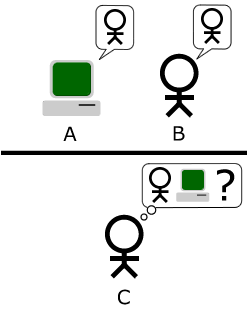Immersion is the process by which a media element entices a person to suspend their disbelief and accept what they are viewing on a screen or page as actual reality. Through non-linear dramatic elements and interaction between the player and the computer, a video game achieves a level of reality that demands very little suspension of disbelief and is therefore a more compelling experience. Further advances in artificial intelligence and new ways of modeling interactive environments serve to make the environment more immersive, until suspension of disbelief is no longer necessary. It is only a matter of time before the dream of a perfectly immersive environment is a reality.
Introduction: Art Imitating Life?
The past decade has witnessed amazing improvements in the field of video game production. Graphics processors can produce effects that mimic real life to an unprecedented level of detail, sound systems can enhance three-dimensional effects with startling accuracy, and modern physical interaction models are leaps and bounds beyond the scampering of the original Mario Bros. With realistic digital movies and real-time technology quickly approaching the fabled “lifelike” quality, a person’s acceptance of a virtual object as real becomes an easier, if not automatic, response. Emboldened by the ability to immerse a player in a virtual environment (see Fig. 1), game developers are turning back to the first questions that were asked at the conception of virtual reality: if the player reaches a significant level of immersion, is the environment real?
What is Immersion?
Suspension of disbelief is the literary term for a reader’s decision to accept what is presented in a story as a real event. It is the first step in the formation of people’s emotional attachment to fictional characters in novels, movies, and video games. Immersion is a technique of lowering a person’s need to suspend their disbelief by removing the text, the seat, or the keyboard, placing a person into the scene itself. Immersion is the removal of the barriers between people and their entertainment, until it is as real to us as everyday life.
Star Trek: The Next Generation made history in its very first episode when it introduced what has become a beautiful dream of the entertainment industry: the Holodeck. The Holodeck is a computer simulation of any situation that a person can imagine. With only a bit of programming, a world can be generated that resembles any thing or place, and mimics anyone, all in an empty 30-foot cube. Although the Holodeck, an invention that creates a perfect sense of immersion, was made through narration and film, many people could not help but think that its creation would someday be inevitable. Indeed, one of Star Trek’s most compelling characteristics is that it made an unreal world seem nearly within reach. And so an entire generation of video game designers and engineers came of age with the desire to create a perfectly immersive environment– one in which a person would not be able to distinguish virtual reality from reality. Luckily, the crucial yardstick to test the success of such a venture has existed for almost 50 years. This metric is called the Turing Test.
Invented in 1950 by the British mathematician and computer scientist Alan Turing, Turing’s Test is a challenge. As shown in Figure 2, the test involves a person sitting at a computer and asking questions of two individuals sitting at computers in different rooms: one is another person, the other is a computer. If at the end of a period of time, say five minutes, the investigator can not determine which respondent is human and which is machine, then the computer can be said to be intelligent [1]. This test applies to more than just automated chat programs, however. Any medium’s ability to immerse the player through intelligent reactions, visuals, or sound is subjected to the same standards. How real is it? How immersive?
The Perfect Medium
But the Turing Test does not necessarily apply to video games, because they operate within a much more restrictive system than that of natural language. A computer-driven character in a game can concern itself entirely with running, jumping, and bouncing off walls; if a person were to assume control of that character, the limitations of the control would confine an intelligent being to very mechanical-looking procedures. In video games, these artificially intelligent creatures are called agents, or bots, and some of the most impressive examples can be seen in the Unreal Tournament series of games. It is often said in developer discussions and game reviews that the bots in Unreal are indistinguishable from actual twelve-year-olds in their ability to maraud the other team [2].
Due to the simplicity demanded by real-time systems, video games are probably not an appropriate medium for developing candidates for the Turing Test. This expectation of simplicity, however, means that video games are perfect for creating an immersive environment because the player’s suspension of disbelief is already primed. The process becomes even easier when the game does something unexpected that exceeds the player’s expectations. The best video games attract people in the same way that great novels or movies do, through emotional stories, color theory, and the ebb and flow of action. Unlike novels and movies, these games take immersion one step further by specifically casting you in the leading role.
Immersion in Games
This feature comes at a price, however, because the player becomes a random element in an otherwise tightly controlled system. Whereas movies and novels can stick to a script, video games are by nature less rigid. This makes the job of a game designer tremendously difficult, since the techniques for character development and story progression that work to aid suspension of disbelief in other media are generally too restrictive for application in games. Many successfully immersive video games lead the player toward completion of pre-planned goals, just like novels and movies. Ideally, when those goals are accomplished and the player is rewarded for those specific successes, the player should feel as though it could not have been accomplished without his skill [3].
Unfortunately, this method presents a dichotomy for the player, because the elements of story and gameplay are naturally separate. Thus, when the two are intertwined in a game, the player often feels that either the story is an unwanted distraction from the gameplay or that the gameplay is a tedious drawing-out of the story. However, the evolution of video games has resulted in a new technique for integrating story and gameplay more intricately than in the past.
Dynamic Systems
Games have always tried to move beyond the linearity of movies and novels. Techniques such as content randomization and writing stories with many paths and endings were the first attempts, and a third, potentially revolutionary method has recently arisen. Based on games like Dungeons & Dragons and Warhammer that play out in dynamic, storyteller-driven worlds, real time strategy and role-playing games began to develop. The real-time strategy genre relies on scripted, movie-like sequences to tell its story, whereas role-playing games often make use of complicated conversation systems. Both, however, tread on untested ground in terms of gameplay. In either genre, the player is dropped into the world and told to make of it what he will. There is always a goal to achieve–a warlord to defeat or an artifact to find– but the means of achieving that goal are left open to the player.
This results in a tremendously complicated design and programming process, but can give rise to an unparalleled range of freedom in terms of gameplay. The player can choose from an infinite number of strategies, because their imagination is the only limit to how they can proceed. As in life, we are given a set of abilities, skills, and procedures, and we are free to use them as we will. Thus, a giant leap is made towards immersion.
The Next Step: Emergence
The steps that were taken by these two genres to bring their gameplay into existence are the very steps that are now being researched as a way of removing the narrative restrictions on all kinds of video games. The technique is called emergence, and is one of the new frontiers in game artificial intelligence. In his book Professional Game Design, Troy Dunniway describes emergence as an efficiency tool:
“The designer . . . can code in every possibility with a simple if/then type of structure, or a programmer can come up with a general system for these problems. . . One of the interesting aspects to designing a game based on systems is that, even when you’ve tested the game to death, someone still comes up with a new and innovative solution. As long as this new solution doesn’t break the game, it can be a lot of fun” [3].
Efficient game implementation is certainly a welcome side effect to emergence, but the observation that it is impossible to test exhaustively implies that the technique has far broader implications.
Emergent Systems Design
Emergence is unpredictable behavior from the computer through systemic level design, which is the process of designing a high concept of what the game should be like, and inventing rules that, when combined, result in the intended “system.” The system adds consistency that would be a painful process to implement through traditional scripting. For example, if the player is hit by a fireball in a system that understands the relationship between fire and flammability, then they will be burned, and maybe even catch fire. From this, the player will determine that fire causes damage, and that objects can be set on fire [4]. Later when the player sees a group of powerful monsters hiding in the forest, a fireball thrown at the trees may be an obvious solution. The system knows that trees light on fire, and moments later they do. Pretty soon, the whole forest is ablaze, and the monsters are burnt marshmallows.
Emergent systems are more intuitive, so the player feels more ‘in control,” and their plans fail or succeed in reasonable ways. As a rule, emergent systems work towards the immersion of the player, rather than against it. For players, this means that future games may be more than just photo-realistic graphics and lifelike sounds. There are boundless opportunities for emergent systems to model interactions, and when these models become sophisticated enough, a person’s choice to suspend disbelief may be all that is necessary.
Emergence of Unpredictable Behaviors
Before getting carried away with a dream, however, we should look at how emergence is being utilized today. For example, emergence augments gameplay especially well in the game Black and White, which bases much of its action on a deeply integrated artificial intelligence model of the human learning process. Your ten-story-tall pet implements this model in discovering its environment and you, its master. By rewarding your pet for certain actions and chastising it for others, you can sculpt your pet’s actions until they are nearly an autonomous extension of your own gameplay style. Unexpected outcomes of this model abound:
“When I was in level 1, I got the healing spell. So I thought, it would be pretty neat to teach my little ape this spell. Since [he] wants to be always kind and generous to the people, he ran to the village to try his new spell. He looked around and I guess there was no one to heal. He got pretty upset about that. So he just picked up a guy and threw him as hard as he could against a mountain. The man . . . survived. He was hurt pretty bad[ly], though, screamed like hell, and was trying to get back to his house as quick[ly] as possible. My ape of course saw that, and healed him. After that he looked at me, all happy and smiling “[2].
Hundreds of these examples exist, all stemming from a very simple learning model. It is easy to conclude that even the dramatic elements that were once thought to be possible only through the rigid control of narration and scripting can now be produced randomly, if the system has an appropriate way of expressing itself.
With a method of dynamically generating events, the missing piece that keeps us from creating an infinite novel or movie is a method that makes stories more meaningful by using a single emergent model that intertwines the player, the characters, and the world. The possibilities are as frightening as they are exciting; for, if a system can conjure up behaviors that mimic real life, has it finally passed Turing’s Test [2]? The world will be a very different place when it does, not just in our methods of entertainment, but also in the very definition of reality.
Conclusion: PCs Can Do Improv
Even in the short term, emergent systems like these help us to better understand the way that we interact with one another and our environment; they may even help us better understand our own thought process. If they follow the computer science model, these crude systems, like binary computer language, might give rise to more readily accessible procedures. Given a sufficiently complex system, is there any interaction that is impossible to model? As on Star Trek, we once again find ourselves gazing at a possibility that seems only barely beyond reach [5].
References
-
- [1] Encyclopedia Britannica 2003. “Turing, Alan M.” Internet: http://www.britannica.com/eb/article?eu=75769, March 13, 2003.
- [2] S. Johnson. “Wild Things.” Wired March, pp. 78-83, 2002.
- [3] T. Dunniway,. [1]Professional Game Design[/i]. New Riders, 2001.
- [4] H. Smith. “Systemic Level Design for Emergent Gameplay.” Game Developer’s Conference Web Lecture. June 6, 2002. <http://www.gamasutra.com/features/slides/smith/index.htm>.
- [5] “Encounter at Farpoint.” Star Trek: The Next Generation. Paramount Pictures: October 11, 1987.






